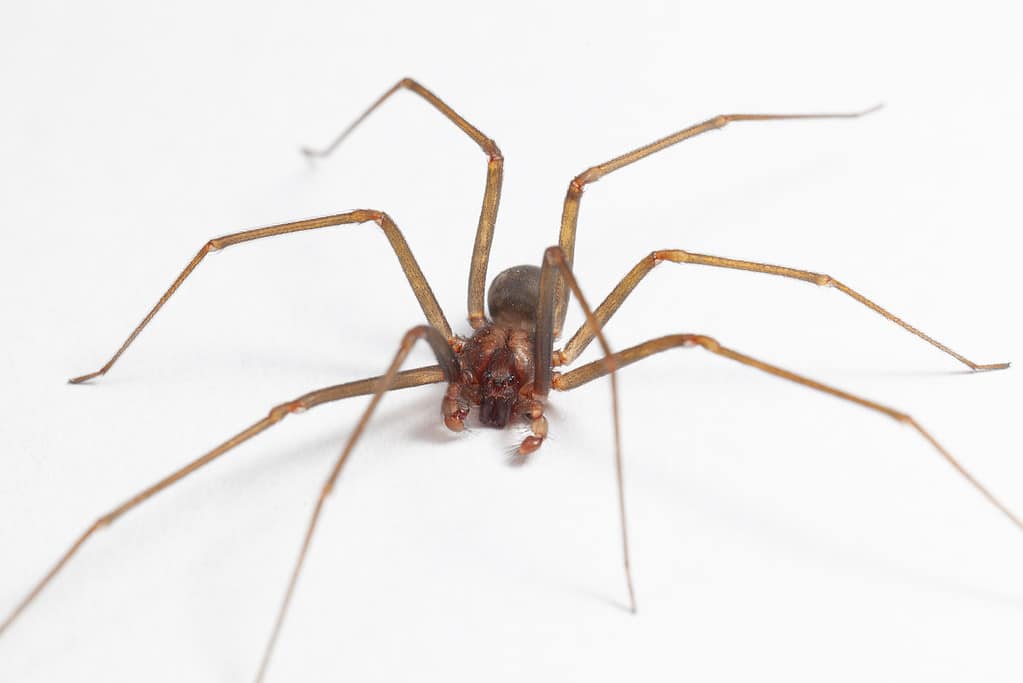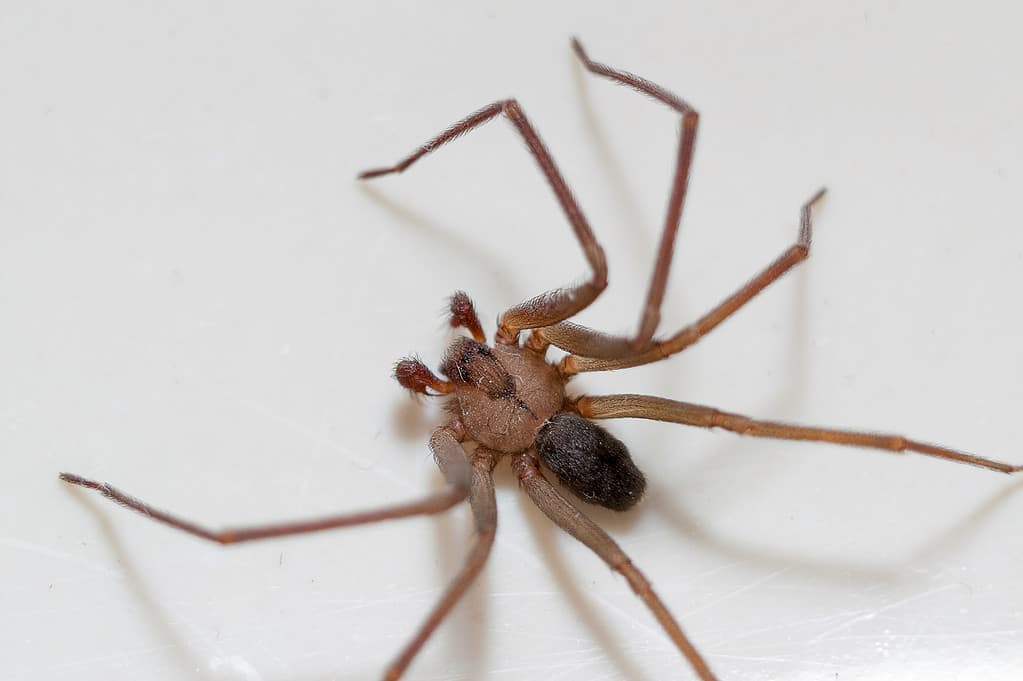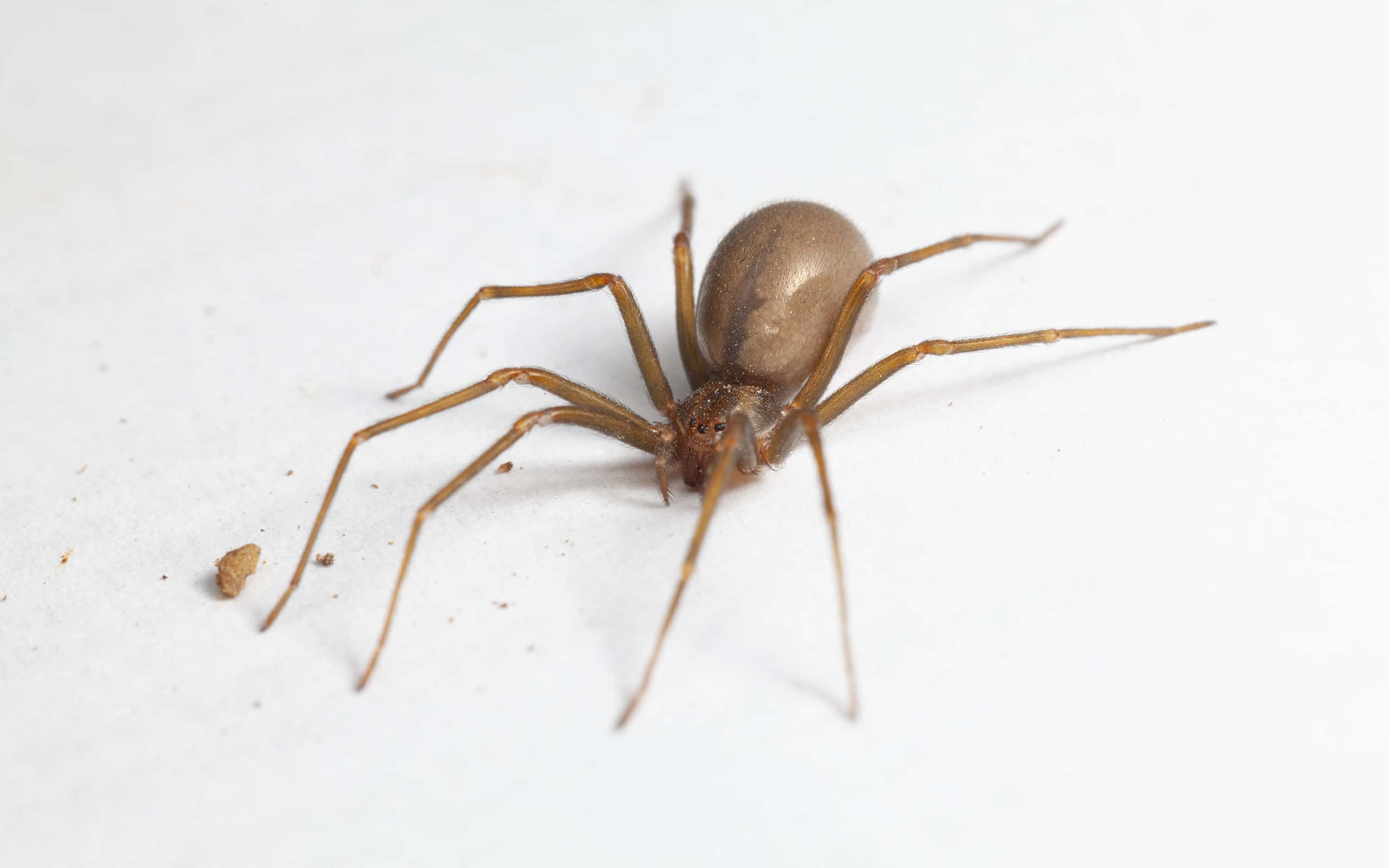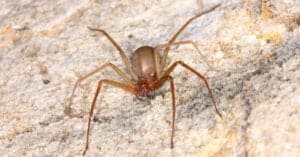The brown recluse (Loxosceles reclusa) is a species of North American spider with a bad reputation. Although small, brown recluses are deemed one of the most dangerous spiders in the world because of their cytotoxic venom.
Brown recluse spiders can be found both outdoors and in urban settlements, but they are rarely found outside their native range. These spiders are recognized by their small size, brown coloration, and three pairs of eyes rather than four.
Their appearance is similar to harmless cellar spiders, and both sexes of this species look alike. This makes it challenging to differentiate between males and females.
Key Differences Between Males and Females

The brown recluse spider is often identified by the violin-shaped marking on its body.
©Nick626/Shutterstock.com
- Male brown recluse spiders are more active than their female counterparts.
- The female brown recluse is nearly double the size of the male.
- Males have longer legs and thickened pedipalps.
- It is easier to differentiate between the sexes of mature spiders.
- Only the males create sperm webs.
- Both males and females are venomous and can bite humans.
How to Tell Male and Female Brown Recluse Spiders Apart
Brown recluse spiders are sexually dimorphic, meaning there are visible differences between the two sexes. Those differences are most noticeable when the spiders are mature or after their final molt. It can be challenging to tell the difference between brown recluse spiderlings because they are small.
Let’s take a look below at the main ways you can identify male and female brown recluse spiders.
Size
The main difference between male and female brown recluse spiders is their size. Females are significantly larger than males, with a body length between 0.24 to 0.79 inches. However, females can be 1 inch in size, leg span included. Males have much smaller bodies at only 0.7 to 0.9 inches, but they have a longer body-to-leg ratio.
Appearance

You can identify a mature male brown recluse by his long legs, thick pedipalps, and narrow abdomen.
©TacioPhilip/iStock via Getty Images
Mature male brown recluse spiders develop thick pedipalps that they use as a reproductive organ. The pedipalps become larger once the male molts for the final time, unlike with females. Their large pedipalps are located close to their chelicerae and are used to transfer sperm. Male spiders create sperm webs and use their pedipalps to store sperm for mating.
When the male brown recluse has a chance to mate with the female, he uses his pedipalps to transfer sperm to her epigynum (genital opening). Females have pedipalps, but they are not as thick as those of the mature males, nor are they used for reproductive purposes.
Another difference between the two sexes’ appearances is that females have a larger and more rounded abdomen. This is mainly why females have a larger body size than males. The body structure of a male is narrower than that of a female, and their long legs are their most distinctive feature.
Behavior
Both male and female brown recluse spiders are active nocturnal hunters. They generally stay close to the ground in search of food and inject their prey with venom. Brown recluse spiders create uneven webs in undisturbed areas like woodpiles, sheds, and outdoor furniture. Females seem to spend more time in the web than males do. The male spiders will venture further from their webs than females and become more active when mature.

Only male brown recluse spiders have thick pedipalps that function as reproductive organs.
©benjaminjk/iStock / Getty Images Plus via Getty Images
Male brown recluse spiders will roam in search of a female after their final molt to reproduce and generally start hunting less. Their main focus becomes finding a mature female brown recluse to mate with and transfer his sperm using his pedipalps when she is subdued.
In hopes of a successful mating, the male brown recluse will try to impress the female. He will display strange dance-like movements by waving his pedipalps and legs. Males likely resort to these dances because they display their reproductive organs and make the female mistake them for prey. When she is willing, the male brown recluse spider will insert his pedipalps into her epigynum.
Egg Laying
Females lay eggs after being fertilized by the male. They will typically lay about 50 eggs at a time in a silky sac that is stored on the web. The females will guard the egg sacs until the spiderlings hatch after four weeks.
Lifespan
The average lifespan of brown recluse spiders is around two to four years, but males may live slightly shorter. Most male brown recluse spiders die shortly after mating and do not molt again when they are mature. The thickened pedipalps and roaming behavior are usually an indication that a male brown recluse is nearing the end of his lifespan, and his sole purpose now is to find a mate.
Venom and Bite
Both male and female brown recluse spiders can bite and inject a potent venom that they use to immobilize their prey. Their necrotic venom contains sphingomyelinase D, an enzyme that causes tissue damage.
They are timid spiders that usually bite when they are feeling threatened and do not pursue. Their bite is painless to humans but dangerous enough that you would need to go to hospital. You are more likely to be bitten by a mature male. This is because they may wander into homes and sheds or take shelter in your clothes and shoes when roaming for females.
In Summary
Although male and female brown recluse spiderlings look similar, they develop sex-specific distinguishable features. Males are always smaller than females, but they have longer legs. Females are about double the size of the males and spend more time near their web.
When males are ready to mate, they create sperm webs and locate a female. Both males and females can bite and have medically significant venom that makes them dangerous.
Thank you for reading! Have some feedback for us? Contact the AZ Animals editorial team.








